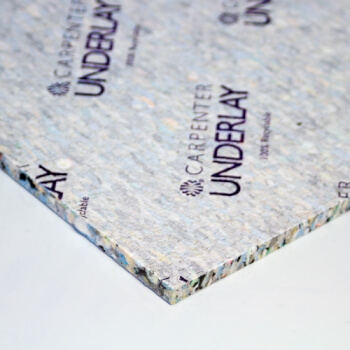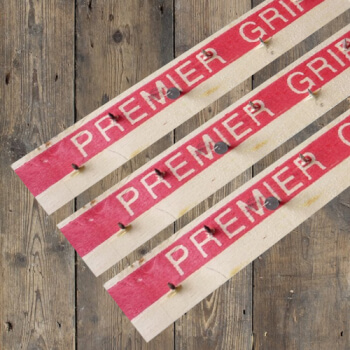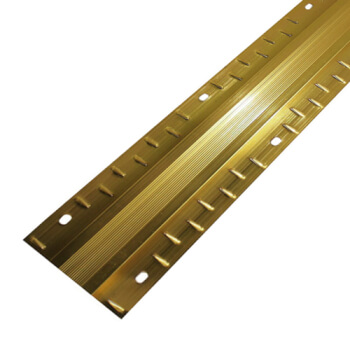A Dyeing Art - How Carpet Gets Colourful
By Jim (01/12/2017)
Hi everyone - it’s barely a month until Christmas and our houses slowly begin to fill with colour - festive greens, reds and golds are all around us. The natural world is abundant with amazing colours and throughout history we have created powders, paints and inks to take these wonderful pigments and make them our own.
And one the earliest - and most consistent - practices in human culture has been dyeing fabric. We already mentioned the Pazyryk carpet on this blog, a 2,500 year old textile found on the Altai mountains - and rich dyes have been associated with status and pageantry from China to North America.
So, here we have a few fun facts about dyes...

Dyed Fabric - Image Found On Wikipedia
How Dyeing Works
The dyeing process has remained more or less unchanged for hundreds of years - in its simplest terms, you need three things: your material, your dye and a mordant. Many other chemicals are used of course, but these are the most important!
* The Right Treatment
Materials can be broken down into three categories - animal (protein, e.g wool), plant (cellulose, e.g. hemp, sisal) and synthetic (nylon, polypropelene). All of these require specific treatment - for example, wool reacts better to acid dyes that plant fibres like cotton. Nylon and viscose will take dye, but other synthetics won’t and have to have pigment added during their creation.

Wool Yarn - Image Found On Wikipedia
* Mordants
A mordant is a substance, often a metal salt, which helps to form a molecular bond between the dye and the fabric. This sets it so that it won’t wash out easily - improving ‘colour fastness’ as it is called.
The name comes from the French word mordre, meaning ‘to bite’ - the belief was that these substance helped the dyes ‘bite’ into the fibres. There are many different types; one of the most commonly used are ‘alums’, sulfates which are particularly useful for dyeing wool.
The mordant used, and the point at which it is added to the process, will produce different results. Not all dyes require a mordant to set, but the majority used for carpet production do.
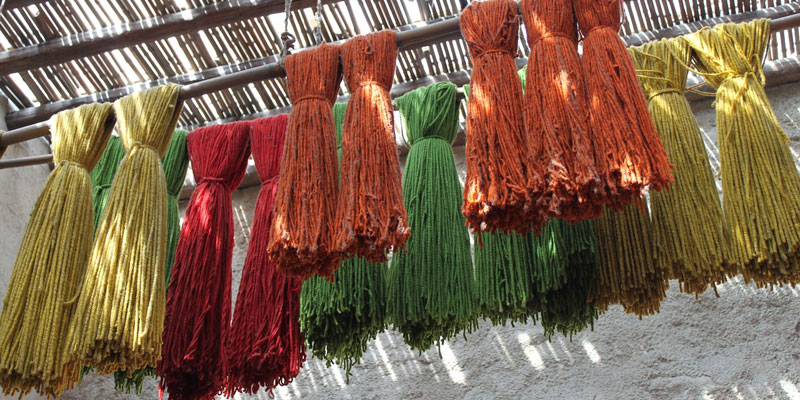
Hank Dyeing - Image Found On MaxPixel
* The Dyeing Process
All natural materials need to be ‘scoured’ (i.e. cleansed of all oils, grease, dirt etc.) before dyeing, in order for the colour to take properly - after this, there are two main methods of dyeing fabric.
Traditionally, craftspeople used ‘hank dyeing’, which involves dipping the yarn, (often suspended by a hook), into a dye pot, where it is held for several hours and then dipped again - it produces good results, but is very time-consuming.
Most modern manufacturers - including those in the carpet industry - rely on ‘package dyeing’, in which spools of wound yarn are immersed in a pressurized container with a bath of dye.
Traditional Dyes
Several natural substances have been turned to create a palette of colours - from lowly ash and soot (used for the ‘lampblack’ or ‘boneblack’ of black ink) to berries, tree resin and animal urine...here are a few of the more interesting or note-worthy ones!
* A Colour From The Deep
Have you ever wondered where the word ‘sepia’ comes from? Well, it’s from order Sepiida - the cuttlefish! These amazing creatures have a rare flare for colour themselves, being very adept at camouflage - but they also produce ink like their squid cousins, which makes a very serviceable red-brown dye.
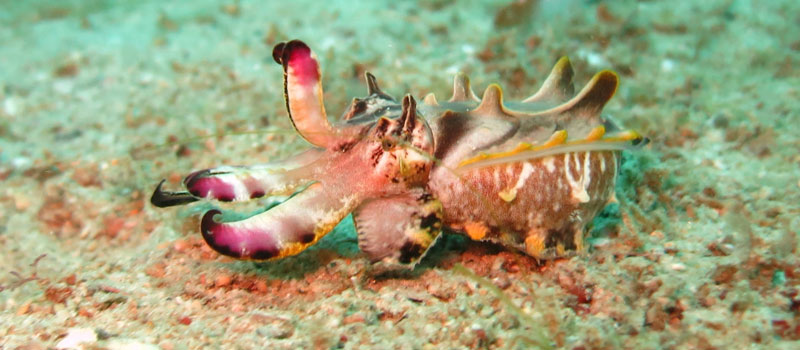
The Flamboyant Cuttlefish - Image Found On MaxPixel
This was used for writing by the ancient Greeks and Romans and was still being used during the Renaissance.
Confusingly, sepia dye was never actually used to give black-and-white photographs a ‘sepia’ effect- this was instead achieved by using a silver sulphide compound in the development process.
* Royal But Rotten
Purple dye has a very important history - or rather, it has a history of being very important. Most people these days associate it with royalty, and this is because of one particular and very expensive dye - Tyrian purple, also known as Murex dye.
Named for the city of Tyre in Lebanon, it was by no means the only way of dying something purple - there were in fact several methods, including the 'dyers moss' orchil (actually a type of lichen) or over-dyeing indigo and madder.
What made Murex dye so special was that it didn’t fade. On the contrary, it actually became brighter and more vivid the longer it lasted.
But there is a hitch - Murex dye comes from a tiny sea-snail, and you only get a couple of drops per snail - in fact, it takes about 10,000 to get just a single gram of dye, which explains why it was only available to the rich. Also, apparently the snails and their dye smelled of rotting fish, something which lasted as long as the colour!
* The Most Useful Insect
‘Scale insects’ are not often welcome in gardens. Many species of this huge family of bugs are pests, such as mealybugs, as they feed off sap and spread plant diseases.
But one particular species, Kerria lacca, has given us everything from gramophone records to safer medicines and varnished furniture. Like many of the scale insects, they secrete a resin, known as ‘Lac’, the pigment of which is used to produce dyes from dark red to light orange.
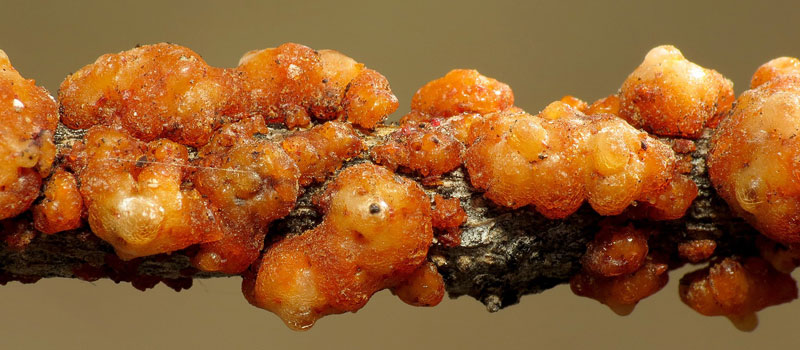
Kerria Lacca - Image Found On WikiPedia
In India and China Lac dyes have been common for thousands of years, with Europeans catching up around the 17th century when trade routes became established.
Incidentally, the ‘lac’ comes from ‘lakh’ meaning ‘100,000’ in Indian numbering and ‘Kerria’ from James Kerr, a medical office in the East India Company who wrote extensively about the insect. Lac can also be refined into a wax, and into ‘shellac’, which has multifarious uses - if you’ve ever had your nails shellacked, you can thank Kerria Lacca!
* Out Of The Blue
The shrub Indigofera Tinctoria is very unassuming -although it is native to warmer climes, it wouldn’t look out of place in any British back garden. A member of the bean family, its seed is not edible - by humans at least - and it’s little pink blooms are unlikely to inspire any poet.
But take its small, round leaves, ferment them and add some lye (why on earth you or anyone else would do this we can only guess) and you end up with dye indigo.

Indigofera Tinctoria - Image Found On WikiPedia
This precious, dark blue pigment has been used by peoples as far removed in time and place as the Moche in Peru (where the oldest indigo-dyed fabric has been found) to the Egyptians of the Old Kingdom.
It was also recorded in China from as early as the Qin Dynasty (221–206 BC) although this was likely produced (until the widespread cultivation of Indigofera) using a different plant, Persicaria tinctoria or ‘Dyer's Knotweed’.
These days almost all indigo is synthetic, but there are still places where it is produced using the traditional method, such as Tokushima in Japan.
Well everyone, that’s all for now!
You may be wondering why green dye isn’t on this list, given how common it is - this is probably because it is easy to ‘overdye’ yellow with blue, much like mixing paints.
If this has got you thinking you’d like something colourful to put on your floor, we have plenty of options for you!
If, on the other hand, you find all these chemicals distasteful, you might prefer something undyed, like Alternative Flooring’s Barefoot range, or the many sisal and seagrass carpets which retain their natural hue.
Enter your required size for our most accurate pricing and availability.








